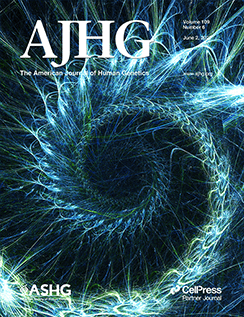Characterizing trends in clinical genetic testing: A single-center analysis of EHR data from 1.8 million patients over two decades.
IF 8.1
1区 生物学
Q1 GENETICS & HEREDITY
引用次数: 0
Abstract
A lack of structural data in electronic health records (EHRs) makes assessing the impact of genetic testing on clinical practice challenging. We extracted clinical genetic tests from the EHRs of more than 1.8 million patients seen at Vanderbilt University Medical Center from 2002 to 2022. With these data, we quantified the use of clinical genetic testing in healthcare and described how testing patterns and results changed over time. We assessed trends in types of genetic tests, tracked usage across medical specialties, and introduced a new measure, the genetically attributable fraction (GAF), to quantify the proportion of observed phenotypes attributable to a genetic diagnosis over time. We identified 104,392 tests and 19,032 molecularly confirmed diagnoses. The proportion of patients with genetic testing in their EHRs increased from 1.0% in 2002 to 6.1% in 2022, and testing became more comprehensive with the growing use of multi-gene panels. The number of unique diseases diagnosed with genetic testing increased from 51 in 2002 to 509 in 2022, and there was a rise in the number of variants of uncertain significance. The phenome-wide GAF for 6,505,620 diagnoses made in 2022 was 0.46%, and the GAF was greater than 5% for 74 phenotypes, including pancreatic insufficiency (67%), chorea (64%), atrial septal defect (24%), microcephaly (17%), paraganglioma (17%), and ovarian cancer (6.8%). Our study provides a comprehensive quantification of the increasing role of genetic testing at a major academic medical institution and demonstrates its growing utility in explaining the observed medical phenome.表征临床基因检测的趋势:对20年来180万患者的电子病历数据进行的单中心分析。
电子健康记录(EHRs)中缺乏结构数据使得评估基因检测对临床实践的影响具有挑战性。我们从2002年至2022年在范德比尔特大学医学中心就诊的180多万患者的电子病历中提取了临床基因检测。利用这些数据,我们量化了医疗保健中临床基因检测的使用,并描述了检测模式和结果如何随时间变化。我们评估了基因检测类型的趋势,跟踪了医学专业的使用情况,并引入了一种新的测量方法,遗传归因分数(GAF),以量化随时间推移可归因于遗传诊断的观察到的表型的比例。我们确定了104,392个测试和19,032个分子确诊诊断。在电子病历中进行基因检测的患者比例从2002年的1.0%增加到2022年的6.1%,随着多基因面板的使用越来越多,检测变得更加全面。通过基因检测诊断出的独特疾病数量从2002年的51种增加到2022年的509种,而且意义不确定的变异数量也有所增加。2022年6505,620例诊断的全表型GAF为0.46%,74种表型的GAF大于5%,包括胰腺功能不全(67%)、舞蹈病(64%)、房间隔缺损(24%)、小头畸形(17%)、副神经节瘤(17%)和卵巢癌(6.8%)。我们的研究提供了一个全面的定量基因检测在一个主要的学术医疗机构日益增长的作用,并证明其在解释观察到的医学现象日益实用。
本文章由计算机程序翻译,如有差异,请以英文原文为准。
求助全文
约1分钟内获得全文
求助全文
来源期刊
CiteScore
14.70
自引率
4.10%
发文量
185
审稿时长
1 months
期刊介绍:
The American Journal of Human Genetics (AJHG) is a monthly journal published by Cell Press, chosen by The American Society of Human Genetics (ASHG) as its premier publication starting from January 2008. AJHG represents Cell Press's first society-owned journal, and both ASHG and Cell Press anticipate significant synergies between AJHG content and that of other Cell Press titles.

 求助内容:
求助内容: 应助结果提醒方式:
应助结果提醒方式:


